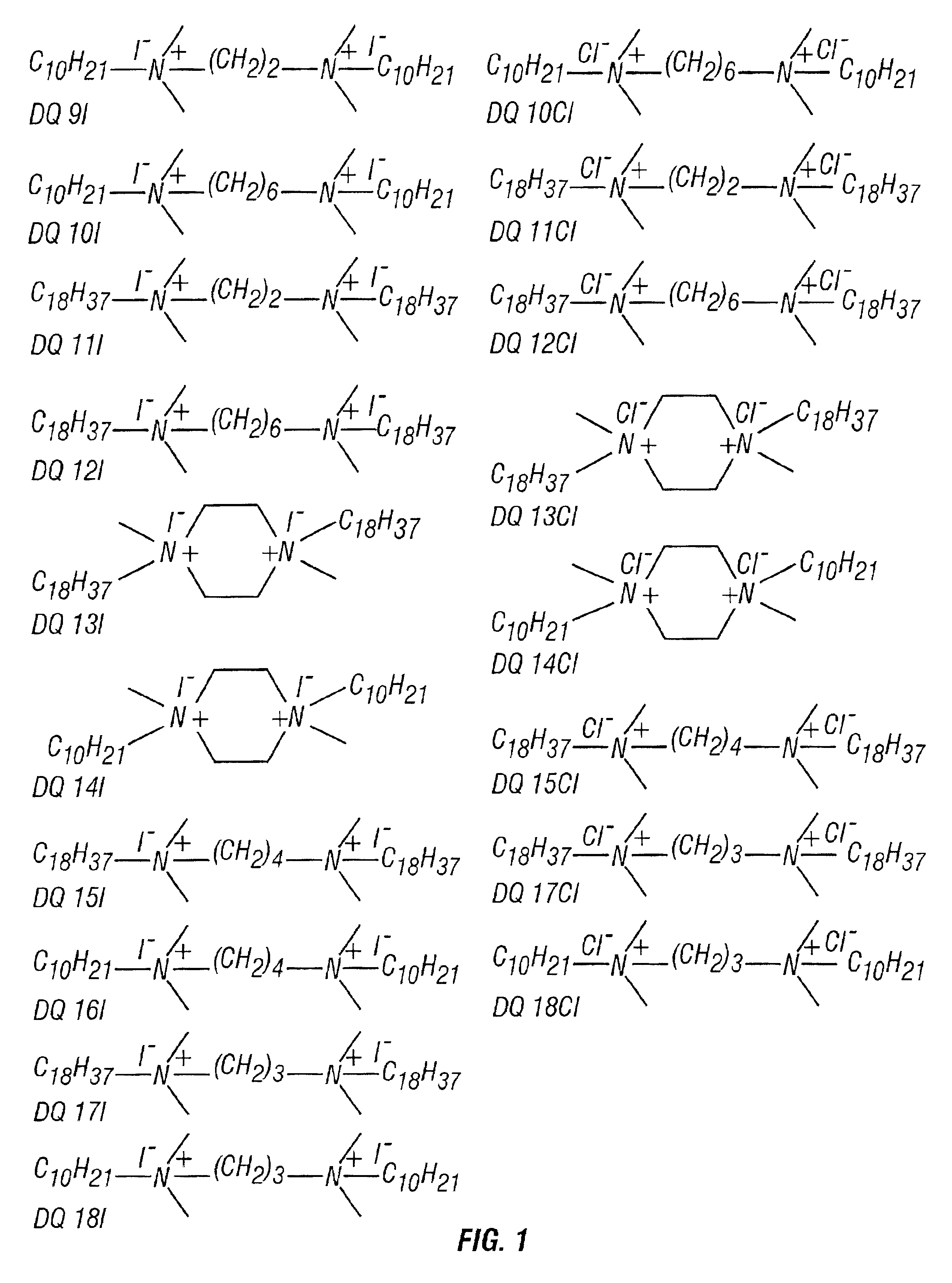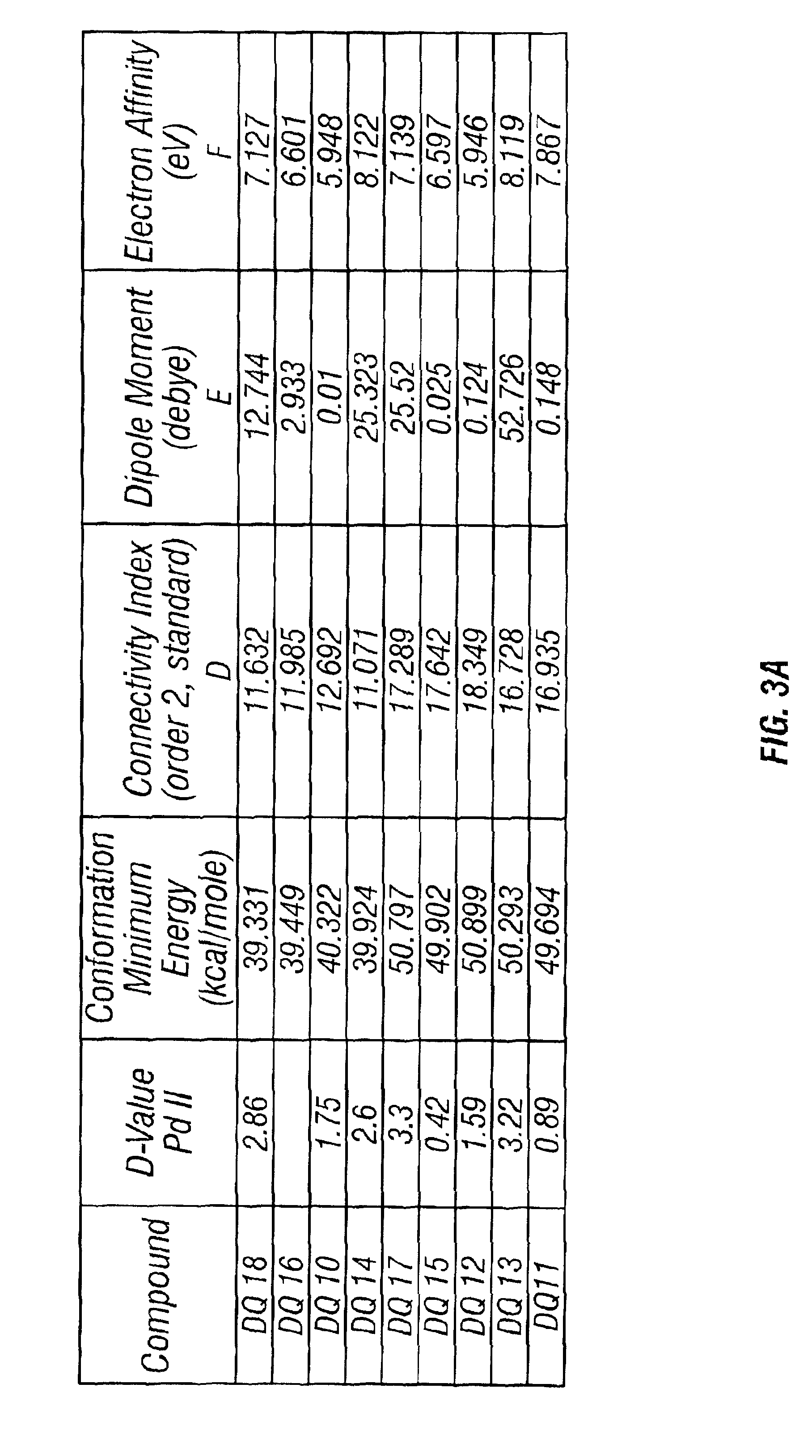Extraction of metals with diquaternary amines
a diquaternary amine and metal technology, applied in solvent extraction, water/sewage treatment by ion exchange, separation process, etc., can solve the problems of large volume of solutions generated from the acid recovery of precious metals from spent catalysts and the like, and the ineffective use of traditional smelting techniques to treat materials such as spent catalysts or electronic scraps
- Summary
- Abstract
- Description
- Claims
- Application Information
AI Technical Summary
Benefits of technology
Problems solved by technology
Method used
Image
Examples
example 1
[0057]Ten diquaternary iodide amines and eight diquaternary chloride amines were synthesized in accordance with the present invention. Each of the synthesized diamines was synthesized from one of the following five different diamines: N,N,N,N-Tetramethylethylenediamine (TMED), N,N,N′,N′-Tetramethyl-1,4-butanediamine (TMBD), N,N,N′,N′-Tetramethyl-1,3-propanediamine (TMPD), N,N,N′,N′-Tetramethyl-1,6-hexanediamine (TMHD), or 1-4-Dimethylpiperazine (DMP). To synthesize one of the diquaternary amines, 10 mM (millimoles) of a diamine selected from those listed above, was added to 25 ml of dimethyl formamide in a 200 ml round bottom flask. An alkyl halide was added to this solution at a molar excess of either 4 times or 6 times the stoichiometric requirement. For a stoichiometric molar excess of 4 times, 40 mM of 1-chloro octadecane (COD) or 1-iodo octadecane (IOD) was added. For a stoichiometric molar excess of 6 times, 60 mM of 1-chlorodecane (CD) or 1-iododecane (ID) was added. Then 0.2...
example 2
[0061]Selected diquaternary amines were used to extract PGMs from solutions of varying acidity to determine the effect of the PGM solution's acid strength on the efficacy of the extraction. Eight solutions were mixed, each containing a selected diquaternary amine dissolved in a mixture of octanol and chloroform at a concentration of 2.5 wt %. Acidic solutions of varying HCL molarity were mixed, each solution containing 50 ppm of one of the following metals: Pd II, Pd IV, Pt II, Pt IV, and Rh III. The HCL acid molarities were 0.5 M HCl, 3 M HCl, and 10 M HCl.
[0062]For each of the selected diquaternary amines, the extraction procedure involved contacting 5 ml of the 2.5% diquaternary amine solution with 5 ml of one of the acidic mixtures of the PGMs in a 20 ml glass scintillation vial for 30 minutes with vigorous shaking. Phase separation was aided by centrifuging the mixture at 2500 rpm for three minutes. Using a Pasteur pipet, the aqueous phase was then removed, placed in another sc...
example 3
[0065]Experiments were conducted using selected diquaternary amines contacted with acidic solutions of PGMs to determine the relative selectivity of selected diquaternary amines towards individual PGMs. An acidic solution containing all three of the PGMs was prepared with the solution containing 50 ppm each of Rh, Pd, and Pt. Using the extraction technique described in Example 2, 2.5% solutions of the selected diquaternary amines, dissolved in either chloroform, 1-octanol or a mixture of the two, were each contacted with the prepared PGM solution. The results are shown in Table 5, supra. The diquaternary amines were shown to be most effective when extracting Pt.
[0066]As shown in Table 5, four out of the eight diquaternary amines showed promising performance towards both Pt and Pd metals, but the best performance was obtained with 13Cl and 14Cl. This fits with the theory that the performance of the diquaternary amines depends upon the number of methylenes, and hence the distance, bet...
PUM
| Property | Measurement | Unit |
|---|---|---|
| Fraction | aaaaa | aaaaa |
| Fraction | aaaaa | aaaaa |
| Fraction | aaaaa | aaaaa |
Abstract
Description
Claims
Application Information
 Login to View More
Login to View More - R&D
- Intellectual Property
- Life Sciences
- Materials
- Tech Scout
- Unparalleled Data Quality
- Higher Quality Content
- 60% Fewer Hallucinations
Browse by: Latest US Patents, China's latest patents, Technical Efficacy Thesaurus, Application Domain, Technology Topic, Popular Technical Reports.
© 2025 PatSnap. All rights reserved.Legal|Privacy policy|Modern Slavery Act Transparency Statement|Sitemap|About US| Contact US: help@patsnap.com



